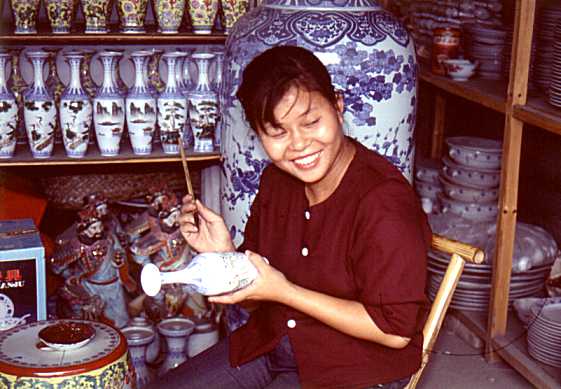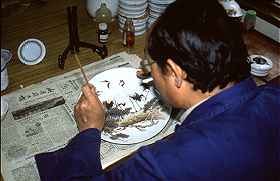
Description of the Twenty
Illustrations of the Manufacture of Porcelain
By Tang Ying, Director of the Imperial Factory at Jingdechen,
in obedience to an Imperial edict... (1743)

Open air enamel decorating of porcelain in Jingdezhen.
Photo © Jan-Erik Nilsson, 1992
17. Round Ware and Vases Decorated in Foreign Style
"Both round ware and vases of white porcelain are painted in enamel colors in a style imitate from Western foreigners, which is consequently called Yang ts'ai, or 'Foreign Coloring.'
Clever artists of proven skill are selected to paint the decoration. The different materials of the color having been previously finely ground and properly combined, the artist first paints with them upon a slab of white porcelain, which is fired to test the properties of the colors and the length of firing they require.

He is gradually promoted from coarse work to fine, and acquires skill by constant practice; a good eye, attentive mind, and exact hand being required to attain excellence.
The colors which are employed are the same as those used for cloisonné enameling upon copper (Fa-lang). They are mixed with three different kinds of medium, the first being turpentine the second liquid glue, the third pure water. Turpentine is best adapted for free coloring; glue is more suitable for thin washes, water for retouching the colors in relief.
While it is being painted the piece is either supported upon a table or held in the hand, or laid upon the ground, according to its size and it is laced in the position most convenient for the read use of the brush."
This page is based on an original translation from Chinese by S.W. Bushell, 1899, of a text written on Imperial command in 1743 by Tang Ying, the celebrated superintendent of the porcelain manufacture in the province of Jiangxi. It is widely reprinted. The version most likely to be authentic is the version found in the official annals of the province of Jianxi, Book XCIII, folio 19-23. The first draft seems to have been written in 1735. The version above was added to a set of 'twenty illustrations of the manufacture of porcelain' in 1743. The actual illustrations have never been identified. The text as it appears here is illustrated with photos taken on location by Jan-Erik Nilsson in 1991 and 1992.

